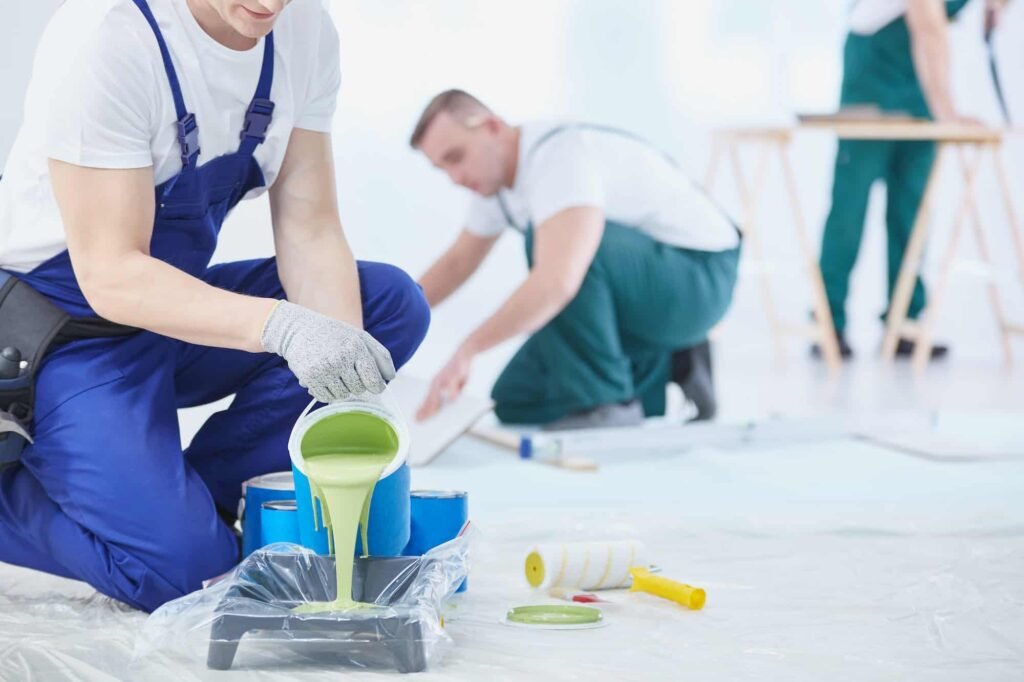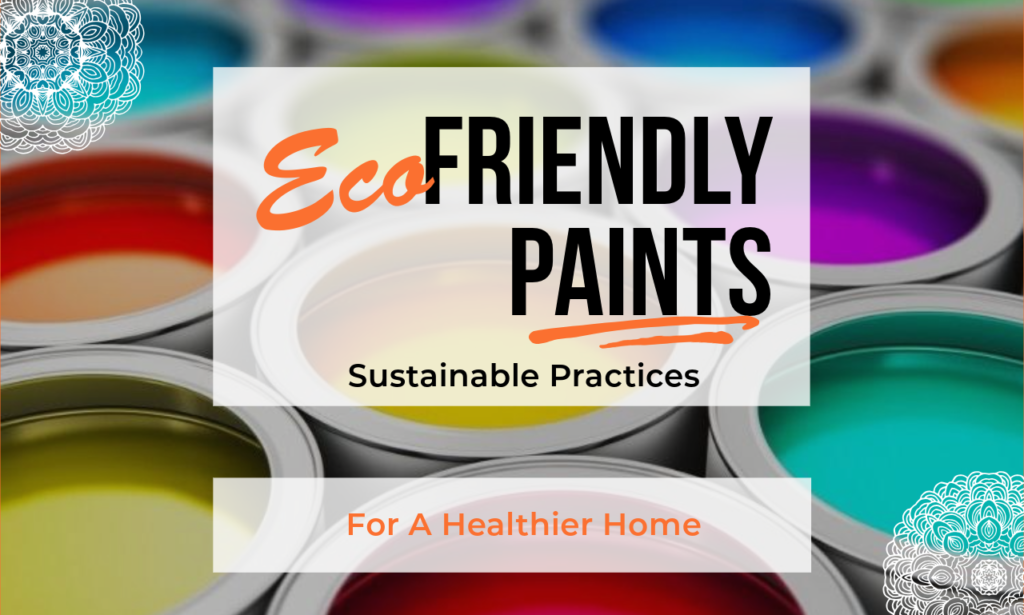Eco-friendly painting reduces environmental impact and enhances indoor air quality. Sustainable practices ensure a healthier, greener home.
Eco-friendly painting is gaining popularity as homeowners seek sustainable living solutions. Traditional paints often contain harmful chemicals that can affect health and the environment. Choosing eco-friendly paints, which are low in volatile organic compounds (VOCs), can significantly improve indoor air quality.
These paints are made from natural, non-toxic ingredients that reduce pollution and waste. Sustainable painting practices also involve using recycled materials and responsibly disposing of paint waste. By adopting these methods, you not only create a safer living space but also contribute to environmental conservation. Eco-friendly painting is a simple yet impactful way to make your home greener.
Introduction To Eco-friendly Painting
Eco-friendly painting is an excellent way to make your home greener. This practice involves using paints that are kind to the environment. Eco-friendly paints reduce harm to the planet and improve air quality at home. They are a perfect choice for anyone wanting a healthier and more sustainable living space.
The Push Towards Sustainable Living
More people are choosing eco-friendly products. This shift is due to growing awareness of environmental issues. Sustainable living means making choices that do not harm the planet. This includes using materials that are safe for the earth. Eco-friendly paints are a part of this movement. They are made from natural ingredients and do not release harmful chemicals.
Benefits Of Choosing Eco-friendly Paint
| Benefit | Description |
|---|---|
| Healthier air | Eco-friendly paints have low VOCs. This means fewer harmful fumes. |
| Less environmental impact | These paints use natural materials. They reduce waste and pollution. |
| Durability | Eco-friendly paints are long-lasting. They need fewer touch-ups. |
Choosing eco-friendly paint has many benefits. It creates a healthier living space. This is because it has lower levels of toxic chemicals. It also supports sustainable practices. This helps to protect our planet. Using these paints can also save money in the long run. They are durable and require less maintenance.

Types Of Eco-friendly Paints
Choosing the right paint for your home is important. Eco-friendly paints are better for the environment. They are also safer for your health. Let’s explore the different types of eco-friendly paints available.
Water-based Paints
Water-based paints are a popular choice for eco-conscious homeowners. These paints use water as the main solvent. They have fewer harmful chemicals.
Water-based paints dry quickly. They have a low odor, making them safe to use indoors. Cleaning up is easy with just soap and water.
Advantages of water-based paints:
- Low odor
- Quick drying
- Easy cleanup
- Less harmful chemicals
Natural Paints
Natural paints are made from natural ingredients. These include plant oils, clay, and chalk. They are free from synthetic chemicals.
These paints are biodegradable. They are safe for people with allergies and sensitivities.
Common ingredients in natural paints:
- Plant oils
- Clay
- Chalk
- Beeswax
Low-voc And Zero-voc Paints
Low-VOC and Zero-VOC paints have very low levels of volatile organic compounds (VOCs). VOCs are harmful chemicals that can cause health issues.
Using these paints reduces indoor air pollution. Zero-VOC paints are the safest option. They contain no harmful chemicals.
Benefits of Low-VOC and Zero-VOC paints:
- Reduced indoor air pollution
- Safer for health
- Environmentally friendly
Why Eco-friendly Paint Matters
Choosing eco-friendly paint is crucial for a healthier home and planet. These paints offer multiple benefits that traditional paints cannot match. They reduce harmful emissions and provide a safer environment.
Health Benefits
Eco-friendly paints have low or zero volatile organic compounds (VOCs). VOCs can cause headaches, dizziness, and even long-term health issues. Using eco-friendly paint ensures cleaner indoor air quality.
These paints also help reduce asthma and allergy symptoms. They are free from harmful chemicals that irritate the skin and eyes. Families with children and pets benefit the most from these non-toxic options.
Environmental Impact
Eco-friendly paints are made from natural and renewable resources. They minimize the carbon footprint and reduce waste. Traditional paints contain harmful chemicals that can pollute air and water.
Here’s a comparison of eco-friendly and traditional paints:
| Aspect | Eco-Friendly Paint | Traditional Paint |
|---|---|---|
| VOC Levels | Low or Zero | High |
| Ingredients | Natural | Chemical-based |
| Environmental Impact | Minimal | High |
Long-term Cost Savings
Eco-friendly paints may have a higher upfront cost, but they save money in the long run. They last longer and require fewer touch-ups. This reduces the overall maintenance cost.
These paints also improve energy efficiency. Light-colored eco-friendly paints reflect more light, reducing the need for artificial lighting. This helps lower electricity bills.
Investing in eco-friendly paint is a wise choice. It benefits your health, the environment, and your wallet.

Preparing Your Home For Eco-friendly Painting
Before starting your eco-friendly painting project, prepare your home properly. This ensures a smooth and sustainable painting experience. Follow these steps for a greener home.
Choosing The Right Color
Selecting the perfect color is crucial. Opt for low-VOC or zero-VOC paints. These paints emit fewer harmful chemicals. Bright colors can reflect light, reducing energy use. For a calm atmosphere, pick neutral shades. Consider the function of each room when choosing colors. Test small areas before painting the entire wall.
Surface Preparation Tips
Proper surface preparation ensures lasting paint. Start by cleaning walls with a mild soap solution. Remove any dust, dirt, or grease. Repair cracks and holes using eco-friendly fillers. Sand rough areas to create a smooth surface. Prime the walls with an eco-friendly primer. This step helps the paint adhere better.
Tools And Materials Needed
Gather all necessary tools and materials before starting. Here is a list of eco-friendly items you may need:
- Low-VOC or zero-VOC paints
- Eco-friendly primers and fillers
- Natural bristle brushes
- Recycled paint rollers
- Drop cloths made from recycled materials
- Sandpaper
- Painter’s tape
- Cleaning rags
Using eco-friendly tools and materials reduces your environmental impact. Choose products with sustainable packaging. This helps minimize waste.
Follow these steps to prepare your home for eco-friendly painting. With the right color, proper surface preparation, and sustainable tools, your home will look beautiful and be better for the environment.
Tip 1: Selecting The Right Paint
Embracing eco-friendly painting practices starts with selecting the right paint. This initial step is crucial for ensuring your home remains both beautiful and environmentally sustainable. Here are some key considerations to help you make an informed decision.
Reading Labels Carefully
Always read the labels carefully before purchasing paint. Look for labels indicating low or zero VOCs (Volatile Organic Compounds). VOCs are harmful chemicals that can affect indoor air quality and health.
Check for certifications such as Green Seal or EcoLogo. These certifications ensure that the paint meets rigorous environmental standards.
Pay attention to the ingredients list. Avoid paints containing hazardous substances like formaldehyde, heavy metals, and phthalates.
Comparing Eco-friendly Paint Brands
It’s essential to compare different eco-friendly paint brands. Some popular brands include Benjamin Moore’s Natura, Behr Premium Plus, and Farrow & Ball.
Use a table to compare the features of these brands:
| Brand | VOC Level | Certifications | Price Range |
|---|---|---|---|
| Benjamin Moore’s Natura | Zero VOC | Green Seal | $$ |
| Behr Premium Plus | Low VOC | EcoLogo | $ |
| Farrow & Ball | Low VOC | None | $$$ |
Comparing these features will help you select the best option for your needs.
Considering Paint Life Cycle
Consider the paint’s life cycle when making your selection. Choose paints that are durable and have a long lifespan. This reduces the need for frequent repainting and minimizes waste.
Some eco-friendly paints also offer recycling programs. These programs allow you to return unused paint for proper disposal or recycling.
Look for paints that are packaged in recycled or recyclable materials. This ensures that you are supporting sustainable practices beyond just the paint itself.
Tip 2: Efficient Painting Techniques
Painting your home can be eco-friendly if you use efficient techniques. This reduces waste and pollution. Let’s explore some tips for effective, sustainable painting.
Using Brushes And Rollers Effectively
Brushes and rollers are key tools in painting. They help apply paint smoothly and evenly. Use high-quality brushes and rollers. They last longer and perform better. Clean them well after use to extend their life.
Load the brush or roller with the right amount of paint. Too much paint leads to drips and waste. Too little paint requires multiple coats. This wastes time and resources.
Use a paint tray to hold your paint. This reduces spills and keeps your work area tidy. Work in small sections to control the amount of paint used. This ensures even coverage and reduces waste.
Minimizing Waste
Minimizing waste is vital for eco-friendly painting. Measure your space before buying paint. This helps you buy the right amount. Avoid overbuying, which leads to leftover paint.
Store leftover paint properly. Seal the can tightly and store it in a cool, dry place. You can use it for touch-ups later. Donate leftover paint if you can’t store it. Many community centers and schools accept paint donations.
Reuse old materials when possible. Repurpose old brushes, rollers, and trays. This reduces waste and saves money.
Proper Cleanup And Disposal
Proper cleanup is essential for sustainable painting. Clean your brushes and rollers with water and mild soap. Avoid using harsh chemicals. They can harm the environment.
Dispose of paint cans responsibly. Check local guidelines for disposal. Many communities have special collection days for hazardous waste. Do not pour leftover paint down the drain. It can contaminate water sources.
Recycle paint cans when possible. Remove any leftover paint and clean the cans. Many recycling centers accept metal and plastic paint cans.
By following these tips, you can paint your home in an eco-friendly way. This helps protect the environment and creates a healthier living space.
Tip 3: Enhancing Indoor Air Quality
Improving indoor air quality is vital for a healthier home. Eco-friendly painting can help achieve this. Using sustainable practices reduces toxins in the air. Here are some effective strategies to enhance indoor air quality while painting your home.
Ventilating Your Space
Ventilation is crucial for fresh air. Open windows and doors to allow air to circulate. Use fans to keep the air moving. This helps remove paint fumes quickly. Install exhaust fans in rooms where you paint. These fans will pull out the harmful air and bring in fresh air. Proper ventilation ensures a healthier environment.
Maintaining Humidity Levels
Humidity control is essential for indoor air quality. Keep your home’s humidity levels between 30% and 50%. Use a dehumidifier if the air is too moist. Use a humidifier if the air is too dry. Balanced humidity prevents mold and mildew growth. It also helps paint dry properly. Monitor humidity with a hygrometer. This small device measures the moisture level in the air.
Choosing Air-purifying Plants
Plants can improve air quality naturally. Air-purifying plants filter toxins from the air. Here are some great options:
- Spider Plant
- Peace Lily
- Snake Plant
- Bamboo Palm
These plants are easy to care for and effective. Place them in rooms where you paint. They will help clean the air and make your home greener.
Tip 4: Sustainable Painting Practices
Adopting sustainable painting practices is a fantastic way to make your home more eco-friendly. By making small changes, you can significantly reduce your environmental impact. Let’s explore some effective strategies under Tip 4: Sustainable Painting Practices.
Recycling Paint Cans
After finishing your painting project, you might have leftover paint cans. Instead of tossing them, consider recycling. Many local recycling centers accept paint cans. Ensure they are empty and dry before recycling. This keeps your home and environment cleaner.
Using Eco-friendly Painting Tools
Traditional painting tools can contribute to waste. Opt for eco-friendly painting tools instead. Choose brushes made from natural fibers. Look for rollers made from recycled materials. Reusable drop cloths are better than plastic sheets. These tools are durable and reduce waste.
Diy Natural Paint Recipes
Many store-bought paints contain harmful chemicals. Try making your own paint at home. Use ingredients like flour, water, and natural pigments. These DIY natural paint recipes are safe and eco-friendly. Here is a simple recipe:
| Ingredient | Quantity |
|---|---|
| Flour | 2 cups |
| Water | 2 cups |
| Natural Pigment | 2 tablespoons |
- Mix flour and water in a bowl.
- Heat the mixture until it thickens.
- Add natural pigment and stir well.
This paint is safe for kids and pets. It also biodegrades easily. Enjoy a beautiful home with a clear conscience.
Tip 5: Embracing A Greener Lifestyle Beyond Painting
Painting your home with eco-friendly materials is a fantastic start. But the journey towards a greener home doesn’t end there. Embracing a greener lifestyle involves making sustainable choices in every aspect of your home decor and maintenance. This holistic approach not only benefits the environment but also enhances your overall well-being.
Eco-friendly Home Decor Ideas
Your home decor choices can significantly impact the environment. Opt for furniture made from reclaimed wood or bamboo. These materials are sustainable and add a unique touch to your home.
- Natural fibers: Choose rugs, curtains, and upholstery made from organic cotton, linen, or jute.
- Low-VOC finishes: Use furniture and decor items with low or no volatile organic compounds (VOCs) to reduce indoor air pollution.
- Energy-efficient lighting: Replace traditional bulbs with LED lights to save energy.
Sustainable Maintenance Tips
Maintaining your home sustainably is crucial for a greener lifestyle. Here are some tips to keep your home eco-friendly:
- Use non-toxic cleaners: Opt for cleaning products that are free from harsh chemicals.
- Water conservation: Fix any leaks and install water-saving fixtures like low-flow toilets and showerheads.
- Regular maintenance: Keep your appliances and HVAC systems in top condition to ensure they run efficiently.
Community Involvement And Awareness
Being part of a community that values sustainability amplifies your efforts. Engage with your neighbors and local organizations to promote eco-friendly practices.
| Activity | Description |
|---|---|
| Community clean-ups | Organize or participate in local clean-up events to keep your surroundings litter-free. |
| Recycling programs | Support and participate in recycling initiatives to reduce waste. |
| Workshops and education | Attend workshops on sustainable living and share your knowledge with others. |
By embracing these sustainable practices, you contribute to a healthier planet and a more enjoyable living environment.

Frequently Asked Questions
How Can I Make My House Eco-friendly And Sustainable?
Install energy-efficient appliances and LED lighting. Use solar panels for renewable energy. Insulate walls and windows. Harvest rainwater and use water-saving fixtures. Choose sustainable materials for furniture and decor.
How Can Painting Be Made Sustainable?
Use eco-friendly paints with low VOCs. Opt for natural brushes and materials. Recycle paint containers. Reduce waste by planning efficiently.
How Does Eco-friendly Paint Help The Environment?
Eco-friendly paint reduces harmful emissions, protects indoor air quality, and uses sustainable materials. It minimizes environmental impact and promotes health.
How Do You Paint Eco-friendly?
Use low-VOC or zero-VOC paints. Choose natural brushes and rollers. Recycle paint cans properly. Ensure proper ventilation during painting. Dispose of waste responsibly.
Conclusion
Embracing eco-friendly painting transforms your home and benefits the environment. Choose sustainable materials and practices for a greener lifestyle. Simple changes make a significant impact. Enhance your home’s beauty while caring for our planet. Start your journey towards a sustainable future today with eco-friendly painting choices.






